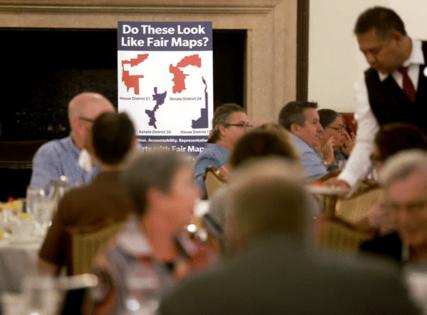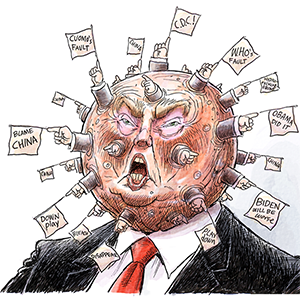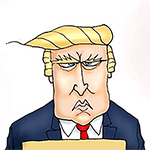Bipartisan group led by ex-Obama officials 'rolling the dice' on new remapping plan for Illinois Legislature
Published in News & Features
The departure of Texas Democrats who spent two weeks in suburban Chicago evading a vote in their state on a Republican-backed redrawing of congressional district boundaries has not ended the conversation on partisan gerrymandering in Illinois.
A bipartisan pair of former high-level officials from President Barack Obama’s administration on Tuesday began their public push to stop state lawmakers from directly drawing their own district boundaries, a change they argue would mean more competitive elections and a General Assembly that better represents the will of the voters.
The “Fair Maps Illinois” proposal marks the third attempt since 2014 to reduce heavy partisan influence in how Illinois district boundaries are drawn following the once-per-decade census. Supporters argue the latest effort, which requires amending the state constitution, will be tailored to fit the narrow frame the Illinois Supreme Court has outlined for citizen-driven amendments after legal challenges struck down similar proposals in 2014 and 2016.
The group — being led by Chicago Democrat William Daley, Obama’s former chief of staff, and Peoria Republican Ray LaHood, Obama’s former transportation secretary — made its announcement just one day after Texas lawmakers headed home after their legislative walkout temporarily prevented the Texas GOP from jamming through a congressional remap and elevated gerrymandering as a national issue.
The Fair Maps Illinois effort wouldn’t affect the drawing of congressional maps and is focused just on the process of drawing district boundaries for the state House and Senate. Still, that issue has created substantial pushback statewide in the past, and backers acknowledge they once again anticipate having to fend off legal challenges.
During a Tuesday morning panel discussion hosted by the Lincoln Forum at the Union League Club of Chicago, LaHood said they are “rolling the dice here” on how the 5-2 Democratic-majority state Supreme Court would rule.
“There are no guarantees that the Illinois Supreme Court, as it exists today, will not throw this out. What we’ve done, though, is structured the language based on what the previous Supreme Court ruled in 2016, No. 1,” LaHood said. “No. 2, there are lots of new members on the Supreme Court. … What we’re saying is: ‘This is what the citizens want. We followed your direction. Now, please don’t rule it unconstitutional, because it’s not.’”
The state’s high court threw out past attempts by ruling that voter initiatives to change the constitution must deal with the structure and procedure of the state legislature.
That’s the reason the plan isn’t attempting to address the congressional district boundaries that have dominated headlines in recent weeks. “We’d love to, but we can’t,” said Michael Dorf, a longtime Democrat election attorney who helped draft the proposal.
To get on the ballot, the proposition would not only need to pass legal muster but supporters would also need to gather more than 328,000 valid signatures from registered voters by May.
If the question makes it onto the midterm ballot in November 2026, it would put a spotlight back on an uncomfortable issue for Democratic Gov. JB Pritzker, who is seeking a third term next year.
After campaigning in support of independent redistricting during his first run in 2018 and vowing to veto partisan-drawn maps, Pritzker in 2021 signed heavily gerrymandered congressional, state legislative and state Supreme Court maps, arguing that they were legal and complied with the federal Voting Rights Act.
More recently, Pritzker, as he eyes a potential 2028 White House run, has tried to position himself as a key figure in the fight against GOP gerrymandering by offering safe haven to the fleeing Texas Democrats and flirting with the idea of redrawing Illinois’ congressional districts if circumstances warrant. He’s also called for independent redistricting nationwide.
In response to questions about whether the governor would support the proposal Daley and LaHood are backing, spokesman Alex Gough pointed to recent comments in which the governor said: “We should have an independent commission. We should have one nationally, so that there’s no dispute about it.”
Asked whether a national independent commission would be a prerequisite for the governor to support a redistricting effort in Illinois that only applies to state legislative districts, Gough responded: “Correct. The governor supports federal laws on fair maps, and until Republicans also support those laws, Illinois will continue drawing maps that preserve the Voting Rights Act.”
Regardless, the governor plays no formal role in citizen-driven ballot measures.
To clear through the courts, the new proposal would change the procedure by which state legislative maps are currently drawn by taking the power to draw district boundaries away from the party that controls the legislature and giving it to a 12-member commission.
Members of the commission would be appointed by the four party leaders in the Illinois House and state Senate, with the House speaker, Senate president and minority leaders in both chambers each getting to appoint one lawmaker from their respective caucuses and two members from outside the legislature. Mapmakers would be prohibited from using data on party registration or voting history in drawing the lines.
If the commission failed to approve maps by a majority vote, a tiebreaking member would be chosen at random from two names, not of the same political party, chosen by the Supreme Court.
To address the structure of the legislature, the proposal would tie the size of the General Assembly to the state’s population as determined by the decennial census, with one state Senate seat per 215,000 residents, rounded down to the nearest odd number. As is now the case, each Senate district would comprise two House districts.
Daley acknowledged during the panel discussion that the system would not entirely eliminate partisan considerations from the mapmaking process but argued it would ideally produce districts that keep communities more intact and lead elected officials to aim for consensus and compromise rather than trying to appease those further to the right and left of the political spectrum who tend to make up a larger share of primary voters.
“We’re not looking for perfection here,” Daley said. “We’re trying to take the limitations of the constitution courts have given us and trying to come up with a better system than just allowing whoever’s got a massive majority in the legislature rigging the whole thing.”
The proposal quickly drew pushback from CHANGE Illinois, a nonpartisan good-government group that backed the 2016 independent maps effort. The organization said in a statement Tuesday that it was “troubled by the initiative’s lack of robust engagement during the development of the proposal with community organizations and leaders, who are most impacted by racial and partisan gerrymandering,” leading it “to question who will benefit if the proposal were to make it on the ballot and ultimately be enshrined in the Illinois Constitution.”
“We will be convening community organizations and leaders to understand the impact this proposal would have on their ability to participate in the remap process and ensure that we collectively elevate those needs and concerns,” the group said, without specifying who would be involved in those conversations.
But among the early backers of the new Fair Maps plan was former Chicago Mayor Lori Lightfoot, who, before her election in 2019, was an attorney for the 2016 independent redistricting effort.
During the question-and-answer portion of Tuesday’s panel, Lightfoot, who had a rocky relationship with Pritzker and the Democratic-controlled General Assembly during her four-year City Hall tenure, took to the microphone to decry what she sees as the fruits of state legislative maps drawn to maximize Democratic power in Springfield.
Decades of “hyper-gerrymandered districts” have produced “supermajorities in both chambers of the General Assembly, to the point where they won’t even talk to Republicans because they don’t need their votes,” Lightfoot said.
“What you end up doing is playing to the extremes of your caucus,” Lightfoot said. “What has that meant for the average taxpayer in the state? And particularly, again, I’m partisan about Chicago. We are paying for the General Assembly’s failure to be accountable to average voters: the pension cost, the failure to deal with real-world issues over and over again, every single session.”
To get the question on the 2026 midterm election ballot, while supporters need more than 328,000 signatures, they aim to collect more than 600,000 from registered Illinois voters to avoid the measure being removed from the ballot due to signature challenges.
Supporters estimate they’ll need to raise at least $3 million to $4 million to pay for professional signature collection, legal representation and efforts to promote the initiative.
It remains to be seen whether the proposal will face organized opposition from the Democratic Party that dominates state government.
Under the past leadership of now-convicted former Illinois House Speaker Michael Madigan, the state party was closely tied to efforts to knock the 2014 and 2016 measures off the ballot.
The party — now run by state Rep. Elizabeth “Lisa” Hernandez of Cicero, who was House sponsor of the current maps that produced Democratic majorities of 78-40 in the House and 40-19 in the Senate and is closely aligned with Pritzker — did not respond Tuesday to a request for comment on the proposal.
_____
©2025 Chicago Tribune. Visit chicagotribune.com. Distributed by Tribune Content Agency, LLC.







Comments